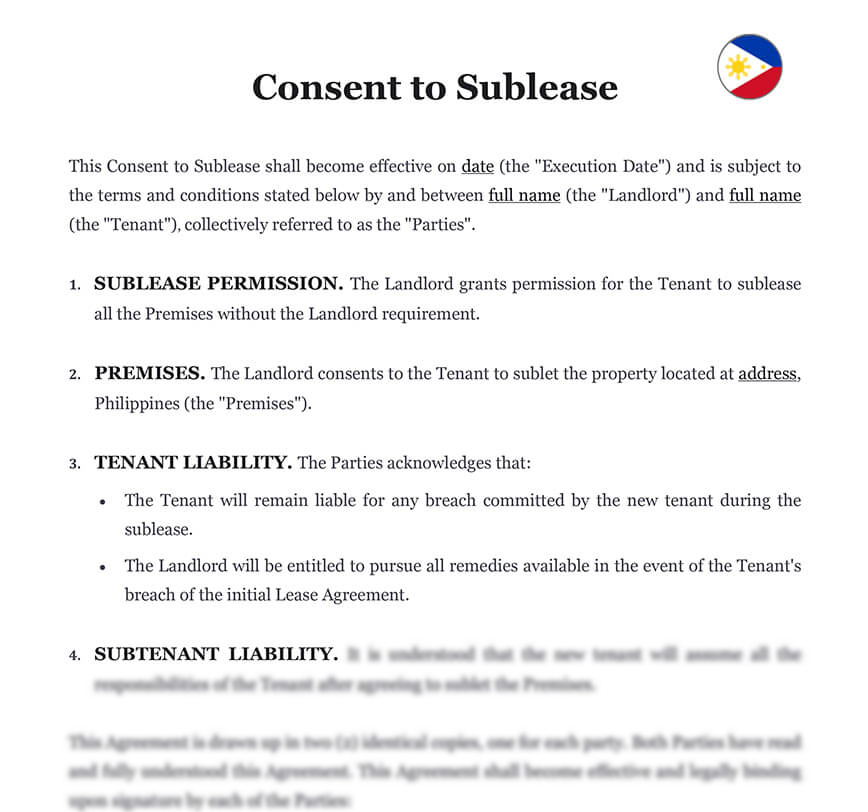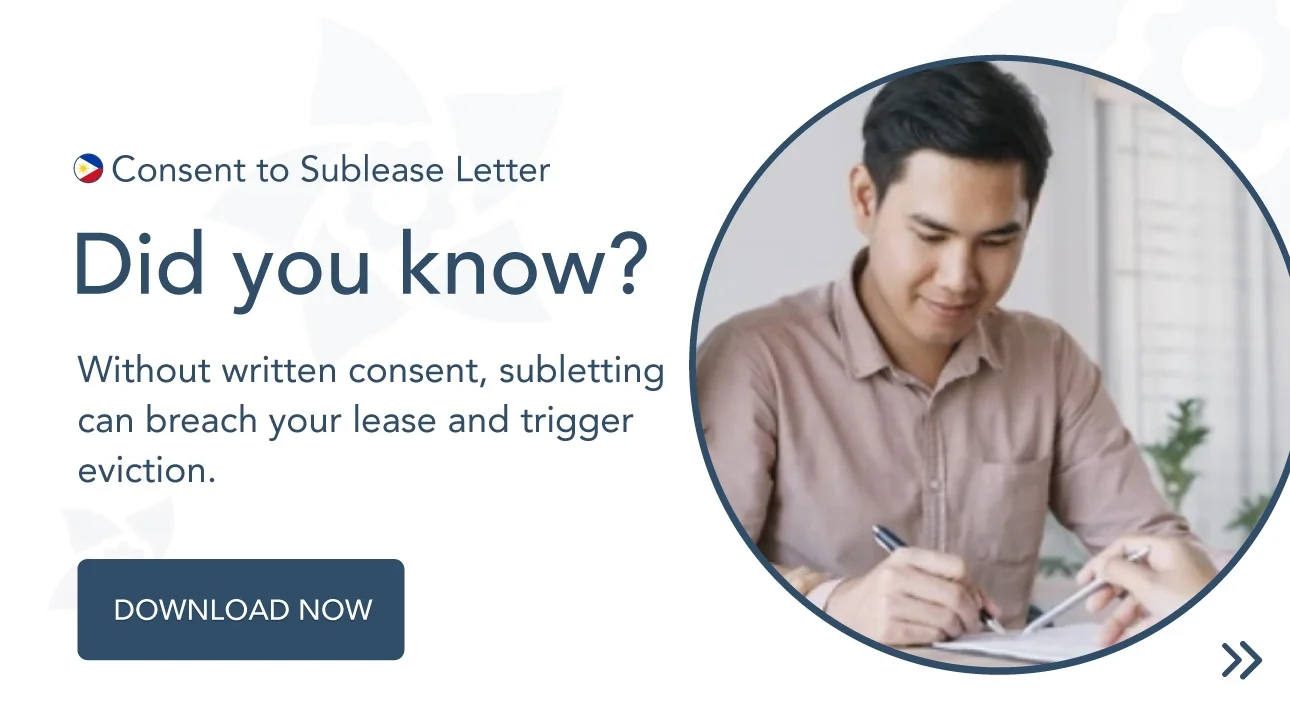Ready to use legal template
Drafted by experienced lawyers
Compliant with Filipino law
Ready to use legal template
Drafted by lawyers
Compliant with Filipino law
Home › Rent your property › Consent to sublease
Learn more about Consent to Sublease in Philippines
A Letter of Agreement to Sublease allows a current renter to sublet his or her apartment under Philippines law. It takes the form of a written agreement signed by the landlord and the tenant that allows for subletting for a duration no longer than the life of the initial Lease Agreement. Subletting may be a possibility if the renter is absent on occasion. It allows rent to be paid even when the tenant is not present. It also allows a current renter to split the rent with someone with whom they want to temporarily occupy the unit. The tenant must provide a copy of the landlord’s written authorization to the subtenant while signing the Sublease Agreement. The Tenant must also furnish a copy of the current master lease agreement.
Table of contents
What is a consent to Sublease Letter?
A permission to sublet is a legal document that both the landlord and the tenant must sign in order for the renter to start a new lease with someone else. This contract contains explicit wording defining who can reside on the property, how much rent will be paid, and what sorts of housing units are permitted.
If there are no restrictions or limitations on occupation under the present Lease Agreement, a permission to sublease is not required. The most typical reason for an owner wanting their renter to sign this paperwork is that they want to sell their house while it is still inhabited.
What are the reasons for subletting?
If it is possible for you, subletting may give flexibility within your rental arrangement.
1. If you don’t live there anymore
This means that you spend more time at a friend’s or a partner’s residence than you do at your own. Maybe you do this because your commute from your actual apartment stinks, or your housemates aren’t the best, or you discovered halfway through the semester that you wanted to move in with your partner but were both locked into yearly leases.
In any event, if you find yourself paying rent a property you seldom visit, why not lease it out and make some money? This way, you may contribute to the cost of your new home without feeling terrible about paying for something you don’t use.
2. If your roommates ditch you
If your landlord does not hold each student accountable for their personal payment and is only concerned with collecting money in general, you may be in a pickle if one of your roommates decides to skip out on the rent. Is this ethical or considerate of them? Of course not, although it does happen occasionally. They may not be so kind as to give you with a subtenant, so you may have to look for one on your own. If your roommates or housemates abandon you, a subtenant can prevent you from not being able to pay the rent on time.
3. If you need to relocate
You might prevent this issue and save money by finding a subtenant who just requires the space while you are away. Make sure to clarify the dates you will be gone for so they aren’t confused about the conditions of the sublease, and make sure to include all the objects in your room in the listing so the subtenant knows what else they will need to bring with them.
4. If you are a student studying abroad
Some students are fortunate enough to be able to graduate a semester or quarter early, but they are then left with a yearlong lease that has yet to expire. If you don’t intend to stay in your college town after graduating early, why not sublet your room so you may begin your new journey somewhere without losing money?
This way, your housemates won’t be able to force you to remain for another few months when all you want to do is go. There are many people seeking for a sublet for the last quarter or semester, so you may be able to advertise as you begin to move your belongings, and then swiftly find someone to ride out the remainder of your contract.
How to give permission to sublease?
It is vital to be careful at all stages of the subletting process in order to protect oneself legally. The technique is as follows:
1. Look into local legislation : Even if subletting is legal in your area, it’s a good idea to review the limits and hurdles to ensure they’re a good fit for your situation.
Consult with your landlord. Some Lease Agreements allow for case-by-case subletting, while others do not, so double-check your lease before continuing. Still, it’s important contacting your landlord to either change your Lease Agreement to enable sublets or seek their consent. Make sure you ask your landlord about the subletting process: Will prospective subletters have to fill out documents and pay fees? How long will it take for them to approve your subletter?
2. Search for a subletter : Inquire with friends and family members if they know of someone looking for a sublet. (A direct recommendation will be easier to vet afterwards.) Alternatively, try posting on social media and apartment listing sites, or look for services that are specifically designed to prospective sublessors. Keep some excellent photographs of the property on hand, and write an honest description of the site that highlights its strengths.
3. Give tours to everyone who is interested : Most interested parties will want to see the house before inquiring about a Sublease Agreement. Prepare your space ahead of time so that guests leave with a positive impression. If in-person visits are not possible, video-conferencing software can be employed.
4. Applicants must be properly screened : To ensure you’re subletting to the right person, make sure they satisfy your income and temperament standards. In some cases, your landlord may want to be a part of this process. Request proof of income and credit score, as well as references from past employers, landlords, or roommates. Depending on your budget, consider hiring a background check company. Finally, interview potential subletters to see if they intend to use the space in a way that conforms to your preferences and level of comfort. Include your roommates in the process so they feel at comfortable.
5. Make a sublet contract : Once you’ve discovered a suitable potential subletter, draft your tenancy agreement or modify an online form to meet your requirements. (Your landlord may also offer you with this agreement.) This agreement should include the move-in and move-out dates, the rent and utilities for which the subletter is responsible, and what furniture or valuables (if any) will remain in the flat. Consider collecting a security deposit in case the subletter damages the flat or your belongings.
Is subleasing legal in Philippines?
Yes, provided he is not restricted to do so by the Contract of Lease.
- Remarks:
When in the contract of lease of things there is no express prohibition, the lessee may sublet the thing leased, in whole or in part, without prejudice to his responsibility for the performance of the contract toward the lessor.
The lessee becomes a lessor to a sublessee in a sublet. The sublessee is then obligated to pay rent to the original lessee. However, the legal relationship between the lessor and lessee is not broken. The original Leasing Contract continues to bind the parties. Thus, there are at least three parties and two unique legal relationships in a sublet transaction.
The sublease of a leased property cannot impact the efficacy of the Lease Contract, which continues to exist with all of its legal effects notwithstanding the sublease. The lessee is nonetheless legally liable for fulfilling his responsibilities to the lessor, according to the law.
What are tenants and subtenants responsibilities?
When subletting an apartment, the original tenant should make every effort to choose someone they feel is trustworthy and will continue to pay the rent. The main reason for this is that the original tenant is still responsible for making sure the rent is paid. The subtenant is typically not compelled to react to the landlord; in most cases, the landlord can only sue the original tenant for rent. The landlord has the power to evict the original tenant if the subtenant fails to pay the rent on time. If the subtenant owes many months of behind rent, the original tenant is responsible for collecting it. Similarly, even if they are no longer residing there, the original tenant is responsible for maintaining the rental in good shape.
SPECIAL OFFER
Landlord
10 Document Package
Essential documents for managing rental property in the Philippines
Consent to Sublease LetterTemplate (.docx)
Easy and quick to customize
310 client reviews (4.8/5) ⭐⭐⭐⭐⭐
Share information
Why Themis Partner ?
Make documents forhundreds of purposes
Hundreds of documents
Instant access to our entire library of documents for Philippines.
24/7 legal support
Free legal advice from our network of qualified lawyers.
Easily customized
Editable Word documents, unlimited revisions and copies.
Legal and Reliable
Documents written by lawyers that you can use with confidence.





